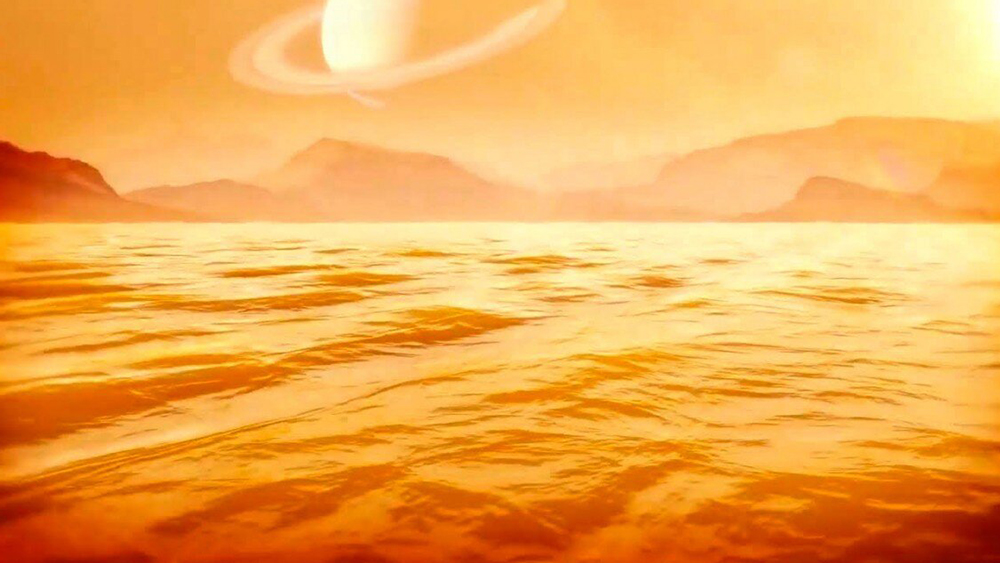Titan is the only moon in our solar system known to have a thick atmosphere. This atmosphere is almost all molecular nitrogen, but about five percent is methane. Ultraviolet light from the sun, as well as charged particles that have been accelerated to high speeds by Saturn’s magnetic field, split apart the nitrogen and methane molecules.2 Chemical reactions then combine the resulting components to produce ethane, as well as propane, acetylene, and benzene.3 What puzzles secular scientists is that the destruction of methane is occurring so quickly that no methane should be left if Titan is billions of years old:
Titan’s solar light—about 100 times less intense than on Earth—constantly converts methane in the atmosphere into ethane; over roughly 10 million-year periods, this process would completely deplete Titan’s surface stores, according to Poggiali.1
Since they believe Titan’s age must be more than a few tens of millions of years, uniformitarian scientists speculate that perhaps the methane in Titan’s atmosphere is being continuously replenished via eruptions of cryovolcanoes or slow seepage through the crust.4 But there is so far no observational evidence for these assumed replenishment processes.
Even if methane were somehow being replenished, the age of Titan’s atmosphere must still be less than one billion years, which is still quite young by secular reckoning. This upper limit is due to the fact that Titan’s atmospheric chemical processes should have produced much more surface methane if it had been going on for any longer than this.4
The problems for old-agers don’t end with methane. Ethane is problematic for them, too. Once produced in Titan’s atmosphere, ethane should fall to the surface. Planetary scientists were confident that it would remain chemically stable. Over long ages, they expected a global ethane ocean hundreds of meters deep to have been formed.3,5 In fact, scientists designed the Huygens probe, which landed on Titan’s surface in 2005, to be capable of landing on both liquid and solid surfaces.6
As it turns out, these liquid bodies cover just a small fraction of Titan’s surface, and most are located near the poles.7 And the lakes near the north pole are mainly methane, not ethane.8 Apparently, ethane production in Titan’s atmosphere has not been going on for very long!
Due to the greater sunlight at lower latitudes, methane lakes near the equator should have evaporated after just thousands of years.7 And secular scientists acknowledge that Titan’s surface shows “surprisingly little erosion.”9
Titan really does look young.3 The presence of atmospheric methane, the absence of large ethane seas, the presence of equatorial methane lakes, and little surface erosion are all indicators that Titan’s maximum possible age is much younger than uniformitarian scientists expected. And Titan’s true age could be just thousands of years. This should not surprise biblical creationists, since the Lord Jesus Christ made Titan, as well as all the other heavenly bodies, around 6,000 years ago.10,11
Stage image: An artistic rendering of the largest sea on Saturn's largest moon Titan.
Stage image credit: NASA/John Glenn Research Center. Copyright © 2020. Adapted for use in accordance with federal copyright (fair use doctrine) law. Usage by ICR does not imply endorsement of copyright holders.
References
1. Friedlander, B. Astronomers estimate Titan’s largest sea is 1,000-feet deep. Phys.org. Posted on phys.org January21, 2021, accessed January27, 2021.
2. Titan: In Depth. NASA Science: Solar System Exploration. Updated December 19, 2019.
3. Coppedge, D. F. 2006. Titan vs. Billions of Years. Acts & Facts. 35 (8).
4. NASA Research Estimates How Long Titan’s Chemical Factory Has Been in Business. NASA. Posted at nasa.gov April 24, 2012, accessed January 28, 2021.
5. Lara, L. M., R. D. Lorenz, R. Rodrigo. 1994. Liquids and solids on the surface of Titan: results of a new photochemical model. Planetary and Space Science. 42 (1): 5-14.
6. Haynes, K. Touchdown on Titan: How we landed a probe on another planet’s moon. Astronomy. Posted on astronomy.com October 19, 2018, accessed January 28, 2021.
7. Thomas, B. 2012. Young-Looking Methane Lakes on Saturn’s Moon. Creation Science Update. Posted on ICR.org July 16, 2012, accessed January 28, 2021.
8. Anderson, P. S. Scientists find new surprises about Titan’s lakes. EarthSky. Posted on earthsky.org April 23, 2019, accessed January 28, 2021.
9. Saturn’s Moon Titan May Have Seen Earth-Like Erosion. Space. Posted on space.com July 23, 2012, accessed January 28, 2021.
10. Genesis 1:14-19, Colossians 1:16-17.
11. Adding up the numbers in the biblical genealogies gives an age of the Earth and universe that are around 6,000 years old.
*Dr. Jake Hebert is Research Associate at the Institute for Creation Research and earned his Ph.D. in physics from the University of Texas at Dallas.


















